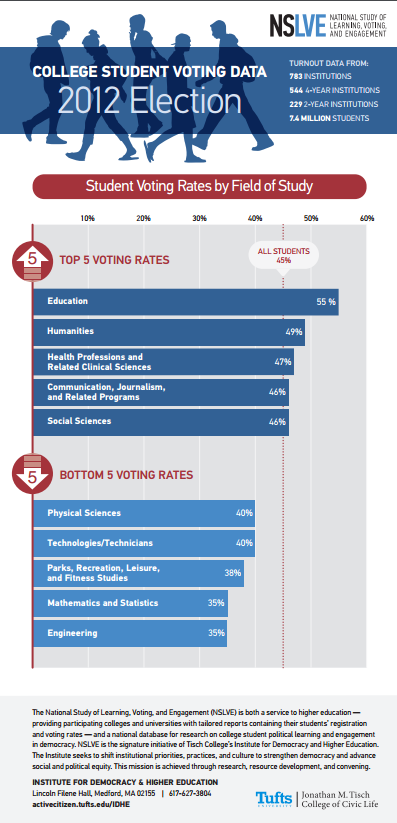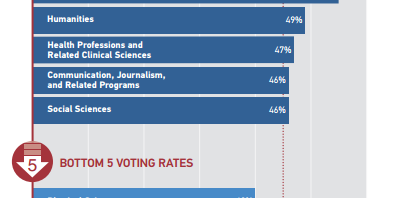- Facebook230
- Twitter1
- Total 231
Medford/Somerville, MA – The National Study of Learning, Voting, and Engagement (NSLVE) at Tufts University’s Jonathan M. Tisch College of Civic Life today released an analysis of the voting patterns of millions of college students, examining voter rates by region of the country, field of study, and type of institution.
These findings, based on a first-of-its kind study of the voting records of 7.4 million students at 783 higher education institutions, could inform opportunities for political learning and outreach on campuses in 2016 and beyond.
Major research findings from this study include:
- Among all fields of study, education/teaching majors voted at the highest rate in 2012 (55%), surpassing the overall average rate of 45% among all students.
- Students studying the humanities (49%) and the health professions (47%) also voted above the average rate.
- Voting rates among students in the STEM fields lagged other disciplines by as much as a 20-point margin. Students in the engineering and mathematics/statistics fields voted at the lowest rate: 35%.
- Among participating institutions, turnout varied considerably by region of the U.S., ranging from a low of 39% in the Southwest (AZ, NM, OK & TX) to a high of 55% in the Plains (IA, KS, MN, MO, NE, ND & SD). See this infographic for the geographical analysis.
- Overall in 2012, student voting rates at 4-year institutions were slightly higher than at 2-year institutions, though there was essentially no difference between private and public colleges and universities.

“These findings suggest considerable disparities across disciplines, and university leaders should take notice,” says Nancy Thomas, Director of the Institute for Democracy & Higher Education at Tufts University’s Tisch College, which runs the NSLVE study. “The fact that education and humanities majors vote at significantly higher rates than their peers in the STEM disciplines has both policy and political implications. We know that young people who engage in civic life early on develop lifelong habits. Regardless of their chosen field, all college and university students should be educated for democracy.”
A previous NSLVE data analysis showed that college students voted at a rate of 45% in 2012, with those eligible to vote for the first time voting at a lower rate of 40%. Women voted at higher rates than men. Among all racial/ethnic groups, Black students voted at the highest rate (55%). Among Black students, women voted at a rate of 61%, while men voted at 44%, which was similar to the voting rate of white men (45%).
The Institute for Democracy & Higher Education will be using NSLVE data to examine important factors in campus political learning and voting during the 2016 election and beyond.
